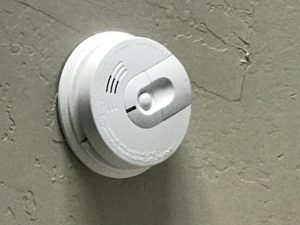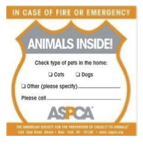Smoke and CO Detectors
Smoke Detectors
Humans lived without smoke detectors and CO detectors for a long time. Since early man first found a way to harness it over 100,000 years ago, humans have had an edgy love affair with fire. With it, man could cook, see in the dark and stay warm. But our attempts to control and live closely with fire have come at great peril because it is a deadly, dangerous exercise.
Safer Homes
This effort appears to have worked because in the 70’s there were nearly 8,000 fire deaths per year in the US, and by 2012 that total had dropped to under 3,000. This is an especially good statistic since both population and the number of housing units have increased substantially since the mid 1970’s.

Family Emergency Plan
It is strongly advised that you and your family design and discuss a plan to execute in the event that your smoke detectors go off unexpectedly. If it does, you should be able to carry out the plan immediately and evacuate the premises until you can determine the cause of the alarm and if it is safe to return. Go here to learn about ways you can make your home more fire resistant and help lower your risk to wildfires.

Maintenance
- 4x per year: dust around the housing and remove cobwebs. Test the unit and change batteries as required by the manufacturer. Note: Please be ultra-careful if you use a ladder to perform any maintenance because more people now die every year from falls, (including from ladders) than from fires.
CO Detectors
The presence of carbon monoxide gas causes these devices to sound an alarm. While CO detectors are definitely not the same as smoke detectors, combination smoke/CO detectors are available. Smoke detectors alert the presence of smoke generated by flaming or smoldering fires, whereas CO detectors warn people about dangerous CO buildup caused, for example, by a malfunctioning fuel-burning device.
Subtle ways CO shows up in your home
Maintenance
- 4x per year: Clean dust from the unit and test and change batteries as indicated by the manufacturer.
Truths About Carbon Monoxide
You need to know about Carbon Monoxide. According to the Centers for Disease Control and Prevention (CDC), over 400 Americans die every year from accidental CO poisoning (not caused by fires.) There are more than 20,000 emergency room visits, and over 4,000 hospitalizations.
-
What is carbon monoxide?
Carbon monoxide (CO) is a colorless, odorless, tasteless gas that is poisonous even in relatively low concentrations. It consists of one atom of carbon and one atom of oxygen.
-
Why is CO poisonous?
Hemoglobin is the molecule in red blood cells that carries oxygen from the lungs to tissues all over the body, then it brings carbon dioxide (CO2) back from the tissues as a waste product and is easily released and exhaled. Carbon monoxide (CO) on the other hand binds to hemoglobin over 200 times more easily than oxygen does, so if CO is present, oxygen will not be able to get into the hemoglobin because the space is occupied with CO. As a result, parts of the body will be starved of oxygen, and the affected parts will die.
-
What are CO poisoning symptoms?
The person may feel as if they have the flu, but without a temperature. If several people in the same building have the same symptoms, they may have CO poisoning. If this happens, all cooking and heating appliances should be switched off, all windows opened, and the local gas safety authorities notified. The longer an individual is exposed to CO, the more severe the symptoms will become. Within a few hours of first being exposed, a person may experience loss of balance, vision problems, memory problems, and eventual loss of consciousness.
If the symptoms are mild, there is a very good chance of a full recovery. Other symptoms may occur later, even months after inhaling CO gas including confusion, memory problems, coordination difficulties. Serious CO gas poisoning can cause long-term problems, including heart damage. People with heart-related or breathing problems tend to be affected more quickly by CO gas poisoning. Pregnant women, babies, and small children are also more susceptible. Pets will react quickly to CO poisoning. If a family pet suddenly gets ill or unexpectedly dies, and the death cannot be linked to anything else, such as age or an existing condition, the owners should try to rule out CO poisoning as one of the possible causes.
-
Where does CO come from?
In the past, some parts of the country used public gas supplies that were extracted from coal. This gas contained carbon monoxide and was so poisonous in its unburned state that it became a popular form of suicide. Thankfully, when the gas was burned, the carbon monoxide also burned and was rendered safe. Since then, most direct sources of carbon monoxide (CO) have been banned. Still problematic CO is generated to some degree whenever anything burns. This includes liquid fuels like gasoline, diesel fuel, kerosene or lamp oil; gasses such as natural gas, LP gas or propane; and solid fuels like wood, paper, charcoal, cloth, etc.Natural gas fuel (methane) has no carbon monoxide and is therefore not poisonous in its unburned raw condition. It is also lighter than air and will float away given a chance.
Fortunately, also with natural gas, higher quantities of carbon monoxide are only created when any of these things happen:- The burner flame “impinges” or hits metal while burning.
- The flame burns with less oxygen than it needs.
- The flame re-burns air it has burned before.
This is good information as natural gas is preferred by many cooks and it is widely used. Heat is evenly distributed with gas, and adjustments are fast. Even heat is also more easily controlled because the flames are visible. An open burner on a residential gas stove produces almost NO carbon monoxide. As soon as you put a metal pot on the burner CO output begins to rise. This is because the ends of the burner flames are contacting the metal pot.
Can I use my oven or cooktop to heat my house?
NO!
During cold weather, occupants keep their homes closed up as tight as possible. This leaves little chance for outside air to enter the structure. As the burners operate they will begin to burn “used” or oxygen-depleted air that has already been burned before. When that happens, the oven will quickly begin producing high quantities of carbon monoxide. The same thing applies to stove-top burners. Eventually, they will burn oxygen-depleted air and emit high levels of carbon monoxide.
Learn about “re-burn” and live
Re-burn is the deadliest situation and is typically what contributes to the few real CO fatalities that do occur every year. Re-burn can also happen when an exhaust flue does not work properly, is blocked or disconnected, or is being back-drafted by some other force like an attic or exhaust fan, or an open window during a windy day. As the gas burners operate they consume oxygen and emit carbon dioxide and water vapor. After a period of time, the oxygen level in the area begins to drop and the flames consume more carbon dioxide and begin generating large quantities of carbon monoxide (CO). Once the flames begin emitting CO, the rate increases quickly to the point where the indoor air becomes lethal.
Re-burn is why any small non-vented gas heater becomes dangerous when operated for periods of time within a confined space. This includes open flame construction heaters, radiant heaters, overhead linear radiant heaters and cook stoves.
All CO is bad CO
Any level of carbon monoxide in the air you are breathing is cause for concern. The long-term effects of continuous low-level exposure have not been sufficiently investigated. There are no long-term studies that have monitored the overall impact of living in a constant CO-laden environment. Even safety organizations (government and private) have different conclusions concerning safe levels of exposure.
Other sources of CO to be aware of?
Household appliances, such as gas fired boilers, central heating systems, water heaters, cookers, and open fires which use gas, oil, coal and wood are possible sources of CO gas.
An idling car engine in an enclosed space can cause CO poisoning within 10 minutes.
If household appliances are well serviced and used safely, they should produce negligible quantities of CO gas. Using old appliances, and not servicing them frequently, leads to a higher risk of CO emission.
Smoking
Smoking cigarettes causes blood levels of CO to rise. Burning charcoal produces CO gas. Blocked flues and chimneys can stop CO from escaping. Fumes from certain paint removers and cleaning fluids can cause CO poisoning. Products that contain methylene chloride (dichloromethane) should be handled with care, because methylene chloride turns into CO when it is breathed in.
The chart below shows the general effects of various levels of exposure. Note that OSHA limits safe exposure at 70ppm for no more than four hours.
| Exposure (in ppm) | Carbon Monoxide Effects |
|---|---|
| 4000 ppm | Death, withing 5 min. |
| 2000-2500 ppm | unconscious, within 10 min. |
| 1000-2000 ppm | Confusion, drowiness, and nausea |
| 600-1000 ppm | Headache and discomfort |
| 25 ppm | SAFE ZONE?? Short term |
Toxic gasses are measured in parts per million (ppm). 1% volume = 10,000 ppm


